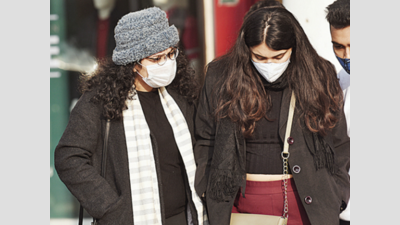- News
- City News
- delhi News
- Delhi at 4.3°C, can’t see beyond 400m
Trending
This story is from January 13, 2021
Delhi at 4.3°C, can’t see beyond 400m
With cold wave conditions seen at isolated places on Tuesday, the city recorded moderate fog during morning hours, while the visibility dropped to 400 metres. The minimum temperature dipped to 4.3 degrees Celsius — three notches below normal — at Safdarjung and maximum was 17.6 degrees Celsius, two degrees below normal. The minimum temperature was lowest at Jafarpur at 3.7 degrees

Ducking for cover
NEW DELHI: With cold wave conditions seen at isolated places on Tuesday, the city recorded moderate fog during morning hours, while the visibility dropped to 400 metres. The minimum temperature dipped to 4.3 degrees Celsius — three notches below normal — at Safdarjung, city’s base station. The maximum was 17.6 degrees Celsius, two degrees below normal.
The minimum temperature was lowest at Jafarpur at 3.7 degrees, while at Lodhi Road it touched 4 degrees Celsius.It is likely to drop further in the next few days. Cold wave conditions are considered when a few stations in Delhi record a minimum of 4 degrees Celsius or less.
Kuldeep Srivastava, scientist India Meteorological Department (IMD), and head, Regional Weather Forecasting Centre, said, “The cold north-westerly winds from hilly areas have led to drop in minimum temperature. The clear sky has also made the nights cooler.”
A Met official said, the minimum temperature was likely to remain at 4 degrees Celsius on Wednesday, while the maximum might touch 18 degrees. Cold wave conditions are expected on Wednesday along with shallow fog, the official added.
Abinash Mohanty, programme lead, Council on Energy, Environment and Water (CEEW), said, “Increasing sea-surface temperature and rapid microclimate changes are intensifying the La Niña phenomenon resulting in below normal winter temperatures. Harsher winters can impact agricultural crop yield and increase exposure to vector-borne and zoonotic diseases, such as Covid-19. While the ongoing winter can be harsher, 2021 will still be among the warmest years on record.”
The air quality in Delhi remained in the “poor” category on Tuesday and is likely to deteriorate to “very poor” and may touch “severe” in the next five days. Delhi’s Air Quality Index (AQI) was 293 on Tuesday.
System of Air Quality and Weather Forecasting and Research, forecasting body under Union ministry of earth sciences, said, “AQI is likely to slip to ‘poor’ or the lower end of ‘very poor’ on Wednesday. It may remain in the ‘very poor’ category on January 14 and 15 due to calm winds and extremely low ventilation.”
The minimum temperature was lowest at Jafarpur at 3.7 degrees, while at Lodhi Road it touched 4 degrees Celsius.It is likely to drop further in the next few days. Cold wave conditions are considered when a few stations in Delhi record a minimum of 4 degrees Celsius or less.
Kuldeep Srivastava, scientist India Meteorological Department (IMD), and head, Regional Weather Forecasting Centre, said, “The cold north-westerly winds from hilly areas have led to drop in minimum temperature. The clear sky has also made the nights cooler.”
A Met official said, the minimum temperature was likely to remain at 4 degrees Celsius on Wednesday, while the maximum might touch 18 degrees. Cold wave conditions are expected on Wednesday along with shallow fog, the official added.
Expecting dense to very dense fog, IMD has issued an “orange” alert for Thursday and Friday.
Abinash Mohanty, programme lead, Council on Energy, Environment and Water (CEEW), said, “Increasing sea-surface temperature and rapid microclimate changes are intensifying the La Niña phenomenon resulting in below normal winter temperatures. Harsher winters can impact agricultural crop yield and increase exposure to vector-borne and zoonotic diseases, such as Covid-19. While the ongoing winter can be harsher, 2021 will still be among the warmest years on record.”
The air quality in Delhi remained in the “poor” category on Tuesday and is likely to deteriorate to “very poor” and may touch “severe” in the next five days. Delhi’s Air Quality Index (AQI) was 293 on Tuesday.
System of Air Quality and Weather Forecasting and Research, forecasting body under Union ministry of earth sciences, said, “AQI is likely to slip to ‘poor’ or the lower end of ‘very poor’ on Wednesday. It may remain in the ‘very poor’ category on January 14 and 15 due to calm winds and extremely low ventilation.”
End of Article
FOLLOW US ON SOCIAL MEDIA










